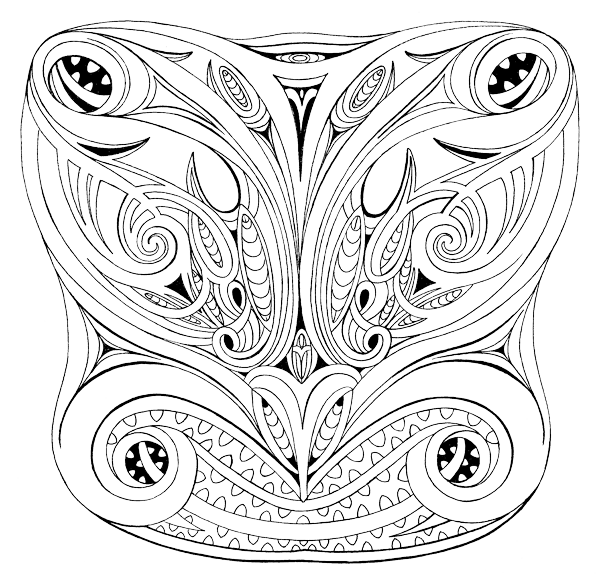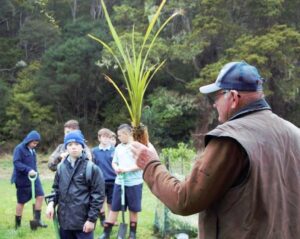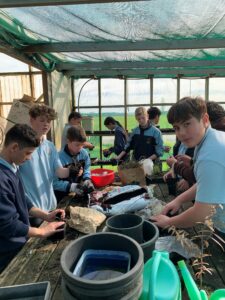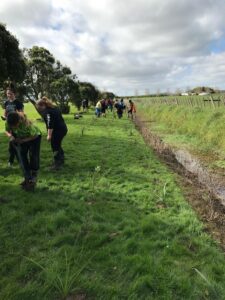
Hinemoana: associated with the sea and fish, sea floor - Female aspect of the sea.
The Kaipara Moana is the largest natural harbour in the Southern Hemisphere, and one of global significance. It is the home to rare and threatened species, including migratory birds from the northern hemisphere, and contains some of the rarest ecosystems in New Zealand, including sand dune, sea grass, freshwater and estuarine wetland ecosystems. It has deep cultural and economic significance. The harbour is home to several iwi/hapū groups, with local taonga species providing food and medicine, underpinning cultural practices and connecting people to place. The Kaipara is also the breeding ground for New Zealand’s valuable snapper fishery. (source: Kaipara Moana Remediation)
When I saw strong similarities in the Kaipara Moana Remediation (KMR) approach to the environment and community to those of Enviroschools, I reached out and engaged with KMR in the early stage of the programme to see what the possibilities were for student engagement.
“The Kaipara Moana Remediation Programme is the largest landscape programme underway in New Zealand. It represents new models of co-governance, planning, collaborating and problem-solving to restore the health and mauri of the Kaipara Moana.” – Kaipara Moana overview
After talking with the KMR team and NRC Regional Coordinator for Enviroschools Northland/Te Taitokerau, Susan Karels, we agreed there was potential for meaningfully engaging young people in local learning and action. I was supported to do the Field Advisor training with KMR. It is KMR policy to find appropriately skilled people in each area and provide additional training to enable them to engage the farmers in their local area to fence and plant their waterways – and in my case, with the schools. This is part of a local approach to support smaller communities and individuals in ways that include supporting local plant nurseries (often small) to supply eco-sourced plants to the farmers in the area.
I then invited Tahiroa Bishop and Griffin Hope, from KMR, to come and talk to interested schools, Ruawai College and Dargaville High School, about what they do towards restoring the health and mauri of Kaipara Moana. We then put our heads together to think how we might work together.

Community partner, Jim Rowlands, from the local Lion’s Club, who manages the Lion’s walkway wetlands by trapping and replanting. Here he is talking to Ruawai College students before planting.
The first early action we took was a planting day at the first local KMR farm. I provided a Sediment Reduction Plan (advising on how to fence and plant waterways on the farm and providing 50% funding) for a local farmer, David Byles, who had already carried out other mitigations against environmental impacts of his farm.
I then contacted the schools to see who wanted to come out as part of their Agriculture/Horticulture (Ag/Hort) class, and help David get the plants in the ground and learn about his land management practices. Taking advantage of being a local, I also invited the volunteer weed control group I coordinate, the local Lions (whom I work with on the Lion’s walkway in Paparoa), Otamatea Harbour Care members (the Board of which I was on for a number of years) and the local community in general. We had a good crew turn up, including the Dargaville Police, and got all the plants in. Some great role models were introduced to the students at the same time.

Ruawai College students plant up wetland species they are growing for planting out into local waterways.
Currently Ruawai College is incorporating a restoration unit into their Ag/Hort course and a lead-in cross-curricular study around the waterways. The vision and mahi of KMR in the junior school is due to kick off next year. We are also looking at the use of the school nursery to grow plants that will then be planted along waterways in the Kaipara Moana catchments. Part of this is connecting the school and local farms with shared waterways to help restore those areas, in partnership with KMR.
Further possibilities we are exploring include piloting a rangatahi field advisor training course.
“Rangatahi working as KMR field advisors would provide a career choice for students enjoying learning and taking action in Enviroschools WaiRestoration projects. When we see a clear purpose for our learning, we are energised to get stuck in, our wellbeing is nurtured, and we’re enabled to work locally.” – Susan Karels, NRC Education Manager and Regional Co-ordinator for Enviroschools
See here for a story about Kaipara Moana Remediation team members joining in an Enviroschools WaiRestoration tour.

The start of planting the school water ways at Ruawai College.

Ruawai college envirogroup timeline for sustainability in the school.